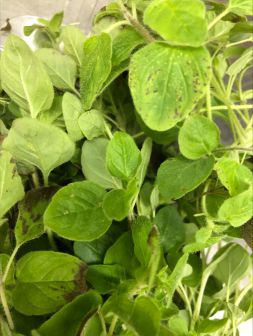Oregano belongs to the Lamiaceae family, and other names for it include Wild Oregano,
Origanum, and Rigani. It is a perennial aromatic herb that can reach a height of up to 70 centimeters. It has relatively small leaves (1-2 cm) that are opposite, oval-shaped, and either entire or slightly toothed. The flowers are arranged in compound inflorescences composed of small spikes. They are small, with bilabiate, white corollas and tubular calyxes with five teeth. It is found in low to mid-altitude, bright, dry areas.
O. vulgare is a species with a wide distribution in Europe and Asia, and it is highly variable in both scent and morphology. In Greece, it is distinguished into three subspecies: subsp. vulgare (northwestern Greece), subsp. viridulum (central Greece), and subsp. hirtum. Only the last one, which is found in Mani and Taygetus, has the strong, characteristic scent of oregano and is widely used in our country, mainly as a seasoning.
It blooms in May in dry, rocky, and wild landscapes of Mani, as well as in stream banks or on the edges of forested areas. Hunters used to gut wild rabbits or partridges and put branches of dried oregano in their bellies to keep them smelling fresh until they returned home.
Today, its use is primarily as a seasoning in various dishes, particularly in grilled fish dishes such as fish heads. In the past, people would eat dried figs together with oregano and walnuts to prevent stomach issues. In Outer Mani, during spring, they would gather green oregano and eat it as a side dish with goat meat and Maniot cheese pies on Easter Monday.
Oregano has stomachic and tonic properties. It is antispasmodic and diaphoretic, suitable for combating atony, anemia, asthma, and dysmenorrhea. Its green leaves are used against hiccups. Other uses include treating constipation, muscle pain, rheumatism, chronic bronchitis, hiccups, and pulmonary tuberculosis, among others. As people say, 'If you want to sneeze, rub your nose with oregano.'
In cooking, oregano is used in soups, sauces, salads, meats, fish, and more. It is often paired with thyme, marjoram, basil, and other herbs.
LATEST RECIPES
GET LATEST UPDATES
Newsletter Subscribe
FEATURED ARTICLE

GET LATEST UPDATES
Newsletter Subscribe























































































